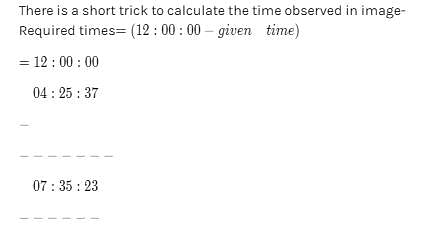Physics: Topic-wise Test- 7 - NEET MCQ
30 Questions MCQ Test NEET Mock Test Series 2025 - Physics: Topic-wise Test- 7
When a plane mirror AB is placed horizontally on level ground at a distance of 60 metres from the foot of a tower, the top of the tower and its image in the mirror subtends, an angle of 90° at B. The height of the tower is:

A unnumbered wall clock shows time 04 : 25 : 37, where 1st term represents hours, 2nd represents minutes & the last term represents seconds, What time will its image in a plane mirror show.
| 1 Crore+ students have signed up on EduRev. Have you? Download the App |
Two plane mirrors of length L are separated by distance L and a man M2 is standing at distance L from the connecting line of mirrors as shown in figure. A man M1 is walking in a straight line at distance 2L parallel to mirrors at speed u, then man M2 at O will be able to see image of M1 for total time :

Which of the following cannot form real image of a real object ?
The radius of curvature of the left & right surface of the concave lens are 10 cm & 15 cm respectively. The radius of curvature of the mirror is 15 cm.
If a symmetrical biconcave thin lens is cut into two identical halves. They are placed in different ways as shown :
A narrow beam of white light goes through a slab having parallel faces
By properly combining two prisms made of different materials, it is possible to
A transparent sphere of radius R and refractive index m. An object O is placed at a distance x from the pole of the first surface so that a real image is formed at the pole of the exactly opposite surface.

If x = 2R, then the value of m is
A transparent sphere of radius R and refractive index m. An object O is placed at a distance x from the pole of the first surface so that a real image is formed at the pole of the exactly opposite surface.

If x = ∞, then the value of m is
Column -II shows the optical phenomenon that can be associated with optical components given in column-I. Note that column-I may have more than one matching options in column-II.

Statement-I : If a source of light is placed in front of rough wall its image is not seen.
Statement-II : The wall does not reflect light.
Statement-I : As the distance x of a parallel ray from axis increases, focal length decreases
Statement-II : As x increases, the distance from pole to the point of intersection of reflected ray with principal axis decreases
Statement-I : When an object dipped in a liquid is viewed normally, the distance between the image and the object is indepedent of the height of the liquid above the object.
Statement-II : The normal shift is independent of the location of the slab between the object and the observer.
Statement-I : When two plane mirrors are kept perpendicular to each other as shown ( O si the point object), 3 image will be formed.
Statement-II : In case of multiple reflection, image of one surface can act as an object for the next surface.
An object is initially at a distance of 100 cm from a plane mirror. If the mirror approaches the object at a speed of 5 cm/s. Then after 6 s the distance between the object and its image will be
A person is in a room whose ceiling and two adjacent walls are mirrors. How many images are formed?
In image formation from spherical mirrors, only paraxial rays are considered because they
A concave mirror of radius of curvature 20 cm forms image of the sun. The diameter of the sun subtends an angle 1° on the earth. Then the diameter of the image is (in cm)
In a Young’s double-slit experiment, the slits are separated by 0.28 mm and the screen is placed 1.4 m away. The distance between the central bright fringe and the fourth bright fringe is measured to be 1.2 cm. Determine the wavelength of light used in the experiment
Shape of the wave front of light emerging out of a convex lens when a point source is placed at its focus.
A beam of light consisting of two wavelengths, 650 nm and 520 nm, is used to obtain interference fringes in a Young’s double-slit experiment. Find the distance of the third bright fringe on the screen from the central maximum for wavelength 650 nm.
A beam of light has a wavelength of 650 nm in vacuum. What is the wavelength of these waves in the liquid whose index of refraction at this wavelength is 1.47?
A beam of light consisting of two wavelengths, 650 nm and 520 nm, is used to obtain interference fringes in a Young’s double-slit experiment. What is the least distance from the central maximum where the bright fringes due to both the wavelengths coincide?
A parallel beam of light in air makes an angle of 47.5∘ with the surface of a glass plate having a refractive index of 1.66. What is the angle between the reflected part of the beam and the surface of the glass?
Shape of the wave front of portion of the wave front of light from a distant star intercepted by the Earth
Which of the following phenomenon cannot be explained by diffraction?
According to Huygens construction relation between old and new wave fronts is
|
1 videos|26 docs|111 tests
|
|
1 videos|26 docs|111 tests
|




























